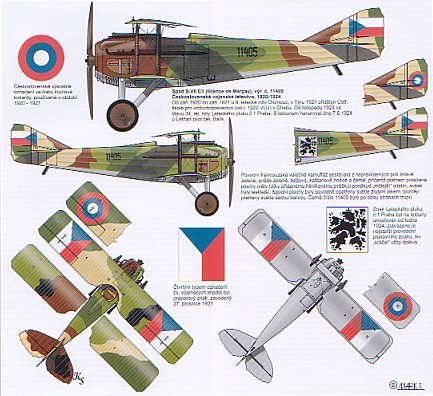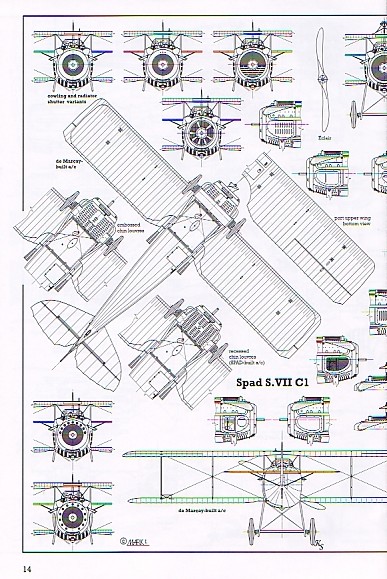|
S u m m a r y
|
| ISBN: |
80-86637-00-X |
| Media: |
Soft Cover; 40 pages plus Czech
translation supplement |
| Price: |
Approx. GBP£11.50 from retailers worldwide
including Hannants |
| Review Type: |
First Read |
| Advantages: |
Clear and interesting selection
of photographs, informative captions, excellent artwork, superbly
detailed plans. |
| Disadvantages: |
|
| Recommendation: |
Highly Recommended |
Reviewed by
Rob Baumgartner

HyperScale is proudly supported by Squadron.com
Having bought previous “4+” publications
there was a certain familiarity that was expected when this latest
edition arrived.
I was interested to see how they would handle the Spad VII, this being
their first World War One subject.
 The
book is essentially an English language publication with a 4-page insert
that provides a Czech translation. English readers shouldn’t throw this
away as it contains additional photos and colour artwork not found
elsewhere in the book. This also includes text (not translated into
English) on the Czech Spads, complete with known serial numbers. The
book is essentially an English language publication with a 4-page insert
that provides a Czech translation. English readers shouldn’t throw this
away as it contains additional photos and colour artwork not found
elsewhere in the book. This also includes text (not translated into
English) on the Czech Spads, complete with known serial numbers.
An introduction to the type is presented in
the first 3 pages including a table of manufacturers and the range of
serial numbers from the machines they produced.
Interspersed throughout the book are at
least 117 black and white photos and 17 colour ones.
Everything is printed on 40 pages of good quality gloss stock. As a
result, the reproduction of the photos is excellent. These pictures are
a mixture of period snapshots and close-ups, as well as the familiar
“walk around” style portrayal of museum pieces.
“Preserved” examples featured are a British (Mann Egerton built) Spad
VII, B9913 from the Virginia Aviation Museum, a Blériot-built Spad VII,
S2489 from the Museo Baracca, Guynemer’s original Spad VII S254 at the
Musée de l’Air et de l’Espace, and a Marçay manufactured Spad VII, s/n
11583 which served in Czechoslovakia. This latter aircraft housed in the
Hart hanger at Kbely Aviation Museum.
The artwork is excellent with 13 different aircraft portrayed.
Represented are Marçay, Blériot, Dux, and Spad built machines. Where
appropriate, scrap views are shown of the upper and lower surfaces,
providing extra detail of the markings and insignia.
A number of extra illustrations are
provided which show the internal assembly of the tailskid, control
column mechanism, engine mount and external stores layout.
 Definitely
one of the highlights of the book is a fold out section that contains
the various 4 view drawings. Not only do we get the “standard” plan and
elevation views, but also numerous scale drawings of the many detail
variations due to the different sub-contractors. Definitely
one of the highlights of the book is a fold out section that contains
the various 4 view drawings. Not only do we get the “standard” plan and
elevation views, but also numerous scale drawings of the many detail
variations due to the different sub-contractors.
These detailed drawings are in 1/48th scale
and show the differences between de Marçay, Mann Egerton, SPAD, Blériot,
Janoir and SEA built aircraft.
A plethora of additional views highlights the different cowl
arrangements, louver styles, radiator types, windscreens, gun sights,
machine gun installations and propellers.
One of the most surprising aspects of the drawings is the depiction of
the asymmetrical shape of the cockpit opening. This is one of the first
titles to clearly show this feature and it is backed up with the
appropriate photographic evidence. Readers should note that this feature
is not be present on all Spad VII aircraft due to the refurbishing of
some with Spad XIII components. On these, the shape is symmetrical.
The penultimate chapter relates to the armament and equipment that these
aircraft carried. There is a discussion on the problems of the early
belt feeds and the subsequent solutions, the different guns used and the
use of Le Prier rockets and Cooper bombs.
Finally we come to the colours and markings section where the reader is
introduced to the painting practices that the Spad VII was accustomed
to. All of the major users of the aircraft are covered to give the
reader a good overall understanding of the subject.
If this is how 4+ Publications
is going to present World War One aircraft in their aviation range of
books then I welcome them with open arms.
The layout is very pleasing
and there is a wealth of information is contained in the modestly sized
format.
The material offered is bound to get the enthusiasts talking and that
can only lead to a better understanding of the type.
Highly Recommended
Thanks to 4+ Publications for
the review sample.
Review Copyright © 2005 by
Rob Baumgartner
This Page Created on 18 January, 2005
Last updated 09 July, 2006
Back to HyperScale Main Page
Back to Reviews Page
|
Home | What's
New | Features
| Gallery |
Reviews | Reference
| Forum
| Search